Marc Schneider's older brother Jack built it over the summer in their family's home garage in 1986. White fiberglass fenders. Exposed engine with an exhaust system loud enough to annoy the neighbors. Aftermarket wheels with big tires. It was a classic Baja Bug. I seem to remember the cab being black and the remains of an old hot rod style flame paint job on the doors, but 30 years later I can't be sure.
Marc and I would push start it every morning senior year so it would get us to high school and then again at lunch time so we could eat off campus. It didn't matter that Mexico's Baja Peninsula was over 3,000 miles from our slice of suburbia in Old Bridge, NJ.
Since the late 1960s, thousands of similar Volkswagen Beetles have been modified for off-road use in home garages all over the world, and the man responsible is Bruce Meyers.
The first Baja 1000 off road race, then called the Mexican 1000, was held on Oct. 31, 1967. Of the 68 vehicles that started the event, only 31 completed the 950-mile run from Tijuana to La Paz. Motorcycles led most of the race, but Vic Wilson and Ted Mangels drove to victory in a Meyers Manx dune buggy built by Meyers on a Volkswagen Beetle chassis. They completed the course in 27 hours and 38 minutes.
That win ignited the popularity of Baja Bugs, like the one that got me to high school. Today, fifty years later, Baja Bugs remain at the core of grassroots offroad competition and the Beetle has more wins in the Baja 1000 than any other model of vehicle. And next month, dozens of VWs will compete at the 50th running of the event as the modern SCORE Baja 1000 still runs several VW-based classes, including one for stock-engined Beetles – Class 11.
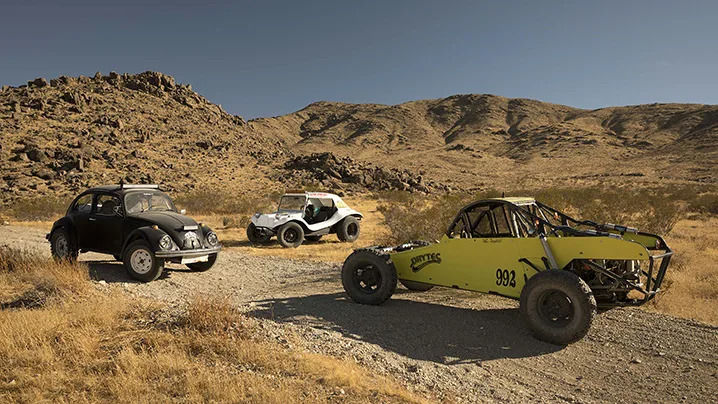
To celebrate half a century of competition, Volkswagen of America acquired one such Class 11 car as part of its Heritage Collection of historically important VW models. Built by Desert Dingo Racing, out of Santa Cruz, California, the 1969 Beetle has seen a few races, including the Mint 400 which is run out of Las Vegas.
A quick walk around the flat black Bug and you'd swear it would have trouble rolling down a hill, much less competing in an off road race. Its rippled body panels have been painted with Krylon's finest and its beefy 15-inch BFGoodrich and General knobbies barely fit under its stock steel fenders. By comparison, Schneider's home-built bug was ready for Pebble Beach.
Incredibly, the suspension is essentially stock. Per class rules, the front axle tube was cut, rotated and rewelded to increase ground clearance and the shock towers have been gusseted for strength. Rear torsion bars are allowed. The set of aftermarket remote reservoir shocks are the most expensive piece of the car.
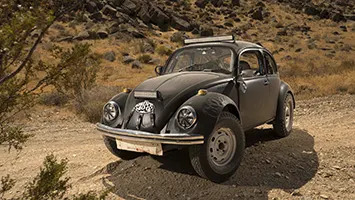
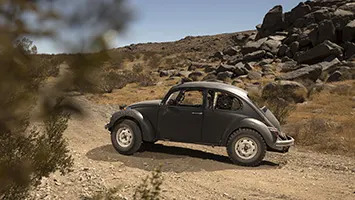

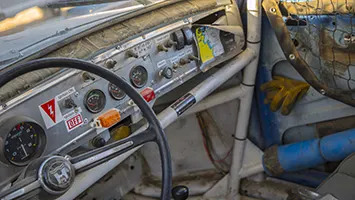
Inside there are aftermarket seats, a makeshift dash with some aftermarket gauges, racing seatbelts, window nets and a rollbar, all of which are coated in decades of accumulated earth. The door panels are bare and the only glass is the windshield. Even the stock large diameter plastic steering wheel remains. A car like this can be built for about $7,000, which is of course much of the appeal.
We're in the Mojave outside Barstow, California, at the Stoddard Valley Off-Highway Vehicle Park running 10 mile laps though rough desert landscape at about 30 mph, similar to what the cars do in Baja.
A mile in and I feel bad for the little car. To keep the momentum up I'm pushing the 1.6-liter engine around 4,000 rpm in second gear and I can hear and feel the large rocks smashing the Beetle's floor pan. The oversized tires are rubbing the fenders and there's a constant clunk in the rear suspension, but incredibly the VW keeps going – and asking for more.
I get it up into third gear and about 50 mph through some loose sand and a two mile long stretch of whoops before I get to the rock garden and hills. Back down to second. Through the rocks, which vary in size from pebbles to bowling balls, the Beetle bangs and crashes its way through. My spine seems to be doing as much work cushioning the impacts as its aftermarket shocks.

Full throttle, I use all 75 horsepower to get up over the first climb and then jamb it into first gear for the decent. There's several inches of play in the Bug's steering and the racing seat belts have already worked their way loose as the 47 year old car bounces through the terrain. I'm holding onto the wheel as much as using it to guide our path, and I'm starting to feel fatigue in my shoulders.
Up and over the next climb I gather speed, grab third gear and head for the "the jump". And for a second there's silence as the 2,500 lbs. VW leaves the desert floor and flies before crashing down into the hard packed and rutted trail. The impact pushes me forward up against the loose belts and jars my sunglasses crooked inside my helmet.
Back in the flatland there's a final two miles of fast but sandy path lined with razor sharp creosote bushes, a bigger threat to the tire sidewalls than the jagged rocks. Although I feel like I'm kicking a wounded puppy, I push the Beetle hard, grabbing third gear again and manage to accumulate enough speed to slide the Bug through the final corner, my sweaty palms fighting for grip on the slick hard plastic steering wheel.
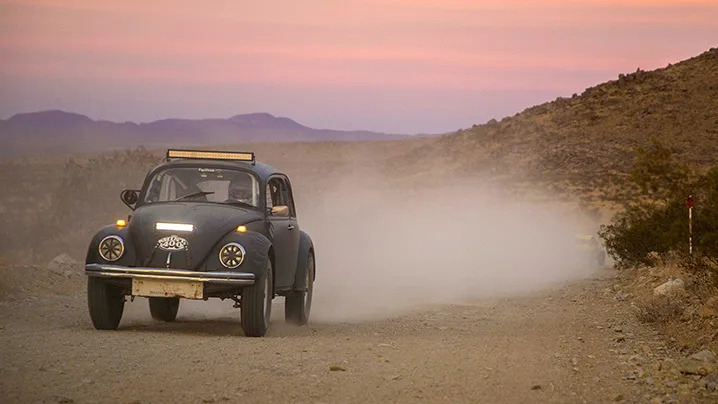
After a Gatorade to wash down the dust, I also drive a much lighter 1,500 lbs. Class 9 buggy, which is a tube chassis single-seater with a 100-inch wheelbase – 5.5 inches longer than the Beetle's. It's also powered by an air-cooled 1.6-liter engine backed by a 4-speed transmission, only this time aftermarket camshafts and dual port cylinder heads are allowed for a few extra horsepower. The compression ratio remains 7.5 to 1.
There's also more rear suspension travel and longer 31.5-inch aftermarket Fox shocks, but it still uses Beetle steering, swing axles and torsion bars, and the combination makes it much harder to drive than the Bug.
There's no windshield. From the driver's seat I can see a few toggle switches on the sheet metal dash, their functions marked in Sharpie, some chassis tubing and two remote reservoirs for the front Fox shocks and of course the exposed front tires.
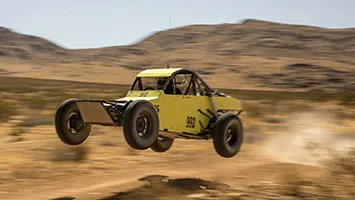
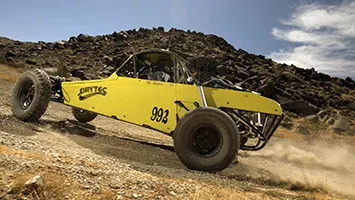
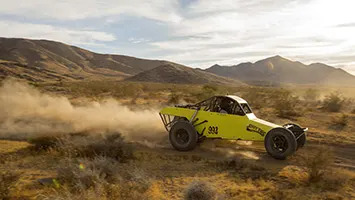
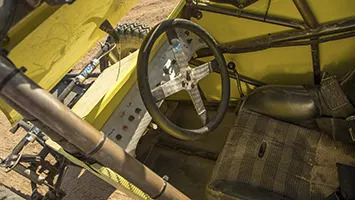
Before I set off I'm told, "Be careful in this one. It's less forgiving than the Beetle and it will dump you upside down. Also, don't wrap your thumbs around the steering wheel, it'll break them."
It's faster than the Beetle, but it's much harder on the driver. The kickback through the buggy's tall front tires and stock Beetle steering system is constant and violent, beating up your hands, forearms, shoulders and upper back muscles. It's like driving a shifter cart on the moon. Racing one through the desert for 1,000 miles and 30 hours is a remarkable accomplishment.
Back in camp my pain is evident. "There's a reason Class 9 buggies are driven by guys 16 to 25 years old," says Cody Jeffers, the man behind Mojave Off Road Racing Enthusiasts (M.O.R.E.), an organization that puts on seven off road races in California and Nevada every year.
After four laps and forty miles I'm done. Toast. Exhausted. But smiling. I'm convinced the original VW Beetle is the toughest car in the world. And the men that have raced these vehicles over raw earth for the past 50 years are heroes.
I want my own Baja Bug more than ever.
Related Video:
Marc and I would push start it every morning senior year so it would get us to high school and then again at lunch time so we could eat off campus. It didn't matter that Mexico's Baja Peninsula was over 3,000 miles from our slice of suburbia in Old Bridge, NJ.
Since the late 1960s, thousands of similar Volkswagen Beetles have been modified for off-road use in home garages all over the world, and the man responsible is Bruce Meyers.
The first Baja 1000 off road race, then called the Mexican 1000, was held on Oct. 31, 1967. Of the 68 vehicles that started the event, only 31 completed the 950-mile run from Tijuana to La Paz. Motorcycles led most of the race, but Vic Wilson and Ted Mangels drove to victory in a Meyers Manx dune buggy built by Meyers on a Volkswagen Beetle chassis. They completed the course in 27 hours and 38 minutes.
That win ignited the popularity of Baja Bugs, like the one that got me to high school. Today, fifty years later, Baja Bugs remain at the core of grassroots offroad competition and the Beetle has more wins in the Baja 1000 than any other model of vehicle. And next month, dozens of VWs will compete at the 50th running of the event as the modern SCORE Baja 1000 still runs several VW-based classes, including one for stock-engined Beetles – Class 11.

To celebrate half a century of competition, Volkswagen of America acquired one such Class 11 car as part of its Heritage Collection of historically important VW models. Built by Desert Dingo Racing, out of Santa Cruz, California, the 1969 Beetle has seen a few races, including the Mint 400 which is run out of Las Vegas.
A quick walk around the flat black Bug and you'd swear it would have trouble rolling down a hill, much less competing in an off road race. Its rippled body panels have been painted with Krylon's finest and its beefy 15-inch BFGoodrich and General knobbies barely fit under its stock steel fenders. By comparison, Schneider's home-built bug was ready for Pebble Beach.
Incredibly, the suspension is essentially stock. Per class rules, the front axle tube was cut, rotated and rewelded to increase ground clearance and the shock towers have been gusseted for strength. Rear torsion bars are allowed. The set of aftermarket remote reservoir shocks are the most expensive piece of the car.




Inside there are aftermarket seats, a makeshift dash with some aftermarket gauges, racing seatbelts, window nets and a rollbar, all of which are coated in decades of accumulated earth. The door panels are bare and the only glass is the windshield. Even the stock large diameter plastic steering wheel remains. A car like this can be built for about $7,000, which is of course much of the appeal.
We're in the Mojave outside Barstow, California, at the Stoddard Valley Off-Highway Vehicle Park running 10 mile laps though rough desert landscape at about 30 mph, similar to what the cars do in Baja.
A mile in and I feel bad for the little car. To keep the momentum up I'm pushing the 1.6-liter engine around 4,000 rpm in second gear and I can hear and feel the large rocks smashing the Beetle's floor pan. The oversized tires are rubbing the fenders and there's a constant clunk in the rear suspension, but incredibly the VW keeps going – and asking for more.
I get it up into third gear and about 50 mph through some loose sand and a two mile long stretch of whoops before I get to the rock garden and hills. Back down to second. Through the rocks, which vary in size from pebbles to bowling balls, the Beetle bangs and crashes its way through. My spine seems to be doing as much work cushioning the impacts as its aftermarket shocks.

Full throttle, I use all 75 horsepower to get up over the first climb and then jamb it into first gear for the decent. There's several inches of play in the Bug's steering and the racing seat belts have already worked their way loose as the 47 year old car bounces through the terrain. I'm holding onto the wheel as much as using it to guide our path, and I'm starting to feel fatigue in my shoulders.
Up and over the next climb I gather speed, grab third gear and head for the "the jump". And for a second there's silence as the 2,500 lbs. VW leaves the desert floor and flies before crashing down into the hard packed and rutted trail. The impact pushes me forward up against the loose belts and jars my sunglasses crooked inside my helmet.
Back in the flatland there's a final two miles of fast but sandy path lined with razor sharp creosote bushes, a bigger threat to the tire sidewalls than the jagged rocks. Although I feel like I'm kicking a wounded puppy, I push the Beetle hard, grabbing third gear again and manage to accumulate enough speed to slide the Bug through the final corner, my sweaty palms fighting for grip on the slick hard plastic steering wheel.

After a Gatorade to wash down the dust, I also drive a much lighter 1,500 lbs. Class 9 buggy, which is a tube chassis single-seater with a 100-inch wheelbase – 5.5 inches longer than the Beetle's. It's also powered by an air-cooled 1.6-liter engine backed by a 4-speed transmission, only this time aftermarket camshafts and dual port cylinder heads are allowed for a few extra horsepower. The compression ratio remains 7.5 to 1.
There's also more rear suspension travel and longer 31.5-inch aftermarket Fox shocks, but it still uses Beetle steering, swing axles and torsion bars, and the combination makes it much harder to drive than the Bug.
There's no windshield. From the driver's seat I can see a few toggle switches on the sheet metal dash, their functions marked in Sharpie, some chassis tubing and two remote reservoirs for the front Fox shocks and of course the exposed front tires.




Before I set off I'm told, "Be careful in this one. It's less forgiving than the Beetle and it will dump you upside down. Also, don't wrap your thumbs around the steering wheel, it'll break them."
It's faster than the Beetle, but it's much harder on the driver. The kickback through the buggy's tall front tires and stock Beetle steering system is constant and violent, beating up your hands, forearms, shoulders and upper back muscles. It's like driving a shifter cart on the moon. Racing one through the desert for 1,000 miles and 30 hours is a remarkable accomplishment.
Back in camp my pain is evident. "There's a reason Class 9 buggies are driven by guys 16 to 25 years old," says Cody Jeffers, the man behind Mojave Off Road Racing Enthusiasts (M.O.R.E.), an organization that puts on seven off road races in California and Nevada every year.
After four laps and forty miles I'm done. Toast. Exhausted. But smiling. I'm convinced the original VW Beetle is the toughest car in the world. And the men that have raced these vehicles over raw earth for the past 50 years are heroes.
I want my own Baja Bug more than ever.
Related Video:
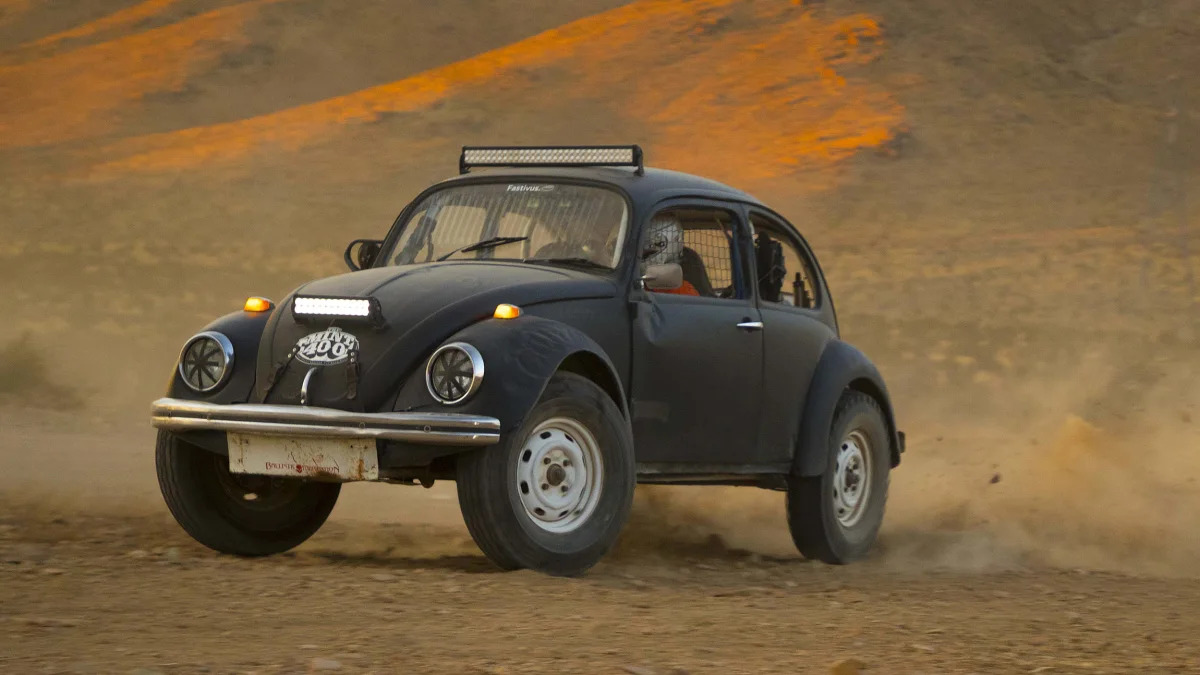









Sign in to post
Please sign in to leave a comment.
Continue